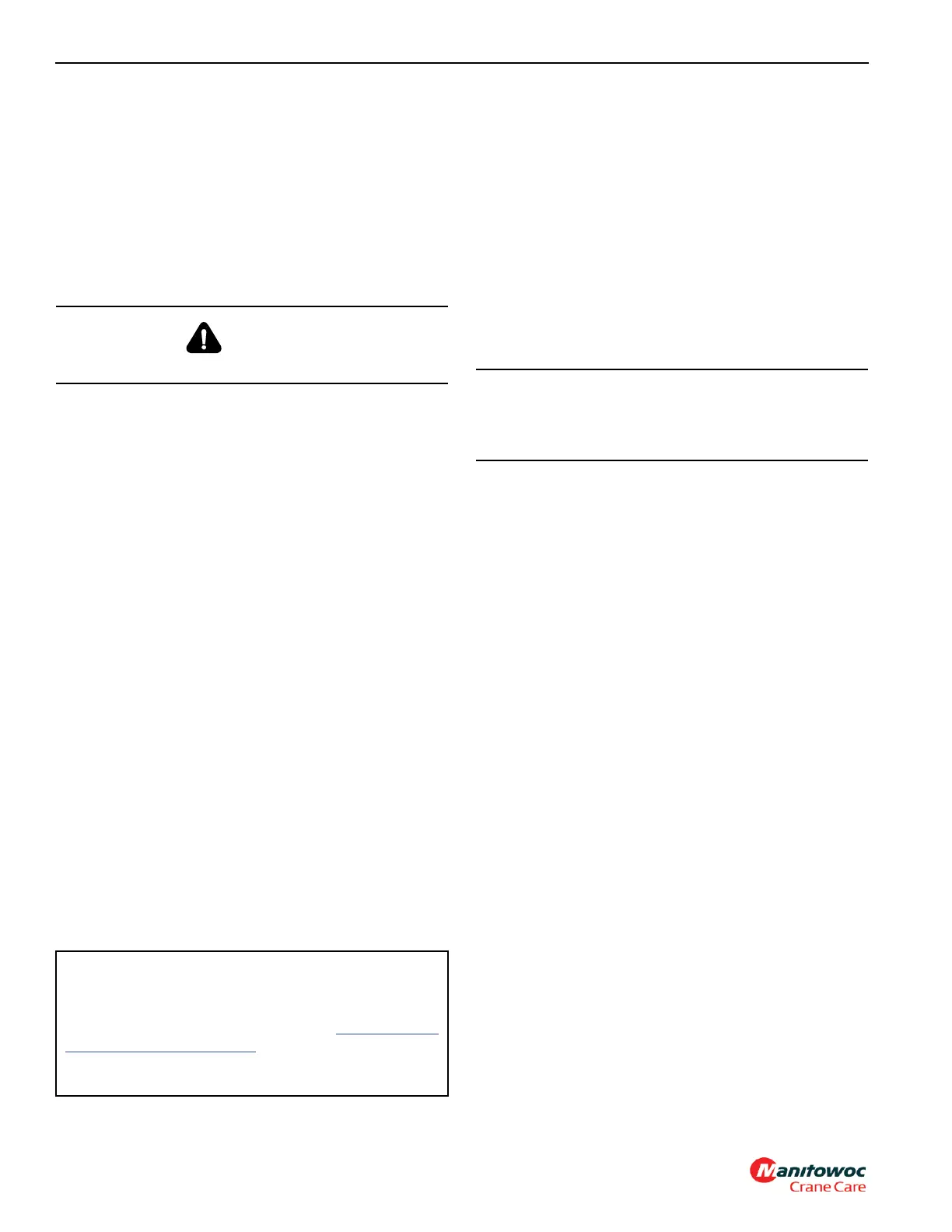BOOM RT880E SERVICE MANUAL
4-16 Published 11-10-2014, Control # 524-00
BOOM EXTENSION AND RETRACTION
CABLE
MAINTENANCE
NOTE: For more detailed information concerning mainte-
nance of the extension and retraction cables, refer
to Wire Rope, page 1-20.
Inspection
The following information is taken from a National
Consensus standard as referenced by Federal Government
Agencies.
All wire rope will eventually deteriorate to a point where it is
no longer usable. Wire rope shall be taken out of service
when any of the following conditions exist.
1. Kinking, crushing, bird caging, or any other damage
resulting in distortion of the rope structure.
2. Evidence of any heat damage from any cause.
3. Reductions from nominal diameter of more than 5%.
4. In running ropes, six randomly distributed broken wires
in one lay or three broken wires in one strand in one lay.
5. In standing ropes, more than two broken wires in one lay
in sections beyond end connections or more than one
broken wire at an end connection.
6. In rotation resistant rope, two randomly distributed bro-
ken wires in six rope diameters or four randomly distrib-
uted broken wires in 30 rope diameters.
7. Severe corrosion as evidenced by pitting.
8. Manitowoc recommends that for cable extended booms,
a single damaged wire rope assembly shall require
replacement of the entire set of extension cables.
9. Manitowoc recommends for cable extended booms, that
boom extension cables be replaced every seven (7)
years.
Adjustment
At near fully extended boom length, during sudden extension
after retracting the boom some distance, and with high
telescoping speeds, the extension cables may slap the
inside of the boom section. This will make a somewhat
audible noise, however this will not cause any damage and is
acceptable. If the cables do not make a slapping noise under
these conditions, it is an indication that the extension cables
may be too tight and should be readjusted. Be aware that
there may also be a similar noise made by the telescope
cylinder rod mount at the rear of the base section and center
mid section and confusion between the two could be
experienced.
NOTE: The extension cables must be adjusted properly
before the retract cables can be adjusted.
1. Extend and set the outriggers, ensuring the crane is
level.
2. Ensure the boom is over the front and at a horizontal
position (boom angle elevation 0 degrees or lower).
3. Extend boom until the front end of the lower telescope
cylinder is accessible through the holes in the outer and
inner mid sections.
4. With the front of the boom in the above position, extend
the boom approximately 1 in (25 mm) to relieve the ten-
sion in the retract cables. Access the retract cables from
the front of the boom nose and view the slack of the
retract cables through the hole in the back plate of the
boom nose. Using the nuts on the retract cables, remove
slack evenly, until both retract cables are at least 1 in (25
mm) above the lower leg of the cable retainer bars on
the sheave mount on the upper telescope cylinder.
5. Retract the boom approximately 1 in (25 mm) to relieve
tension on the extension cables. Shut down the crane.
Evenly tighten the swivel nuts on the adjusting bolts,
until the extension cables are up 6 in (150 mm) off the
top of the bottom pad plate at the back of the fly section.
Look through the holes in the boom sections to see the
slack in cables.
6. Lock the adjustments with the jam nuts.
7. Extend the boom until the outer mid/fly extends several
cm (in).
8. Adjust retract cables so that fly section stop block bot-
toms out 0.12 to 0.19 in (3 to 4 mm) before the stop
block outer mid bottoms out.
CAUTION
Never handle wire rope with bare hands.
CAUTION
Any cutting of this specific wire rope is not recommended.
If 35x7class wire rope must be cut for any reason, it is
necessary to follow the instructions at Installing 35x7
Class Wire Rope, page 1-24. Also, unlike other types of
wire rope, the ends on this wire rope must be welded to
retain the rotation resistant characteristics.
CAUTION
When adjusting cables, hold the cable end and turn the
nut. Do not turn cable. Turning cable while adjusting will
result in damage or failure of cable.
